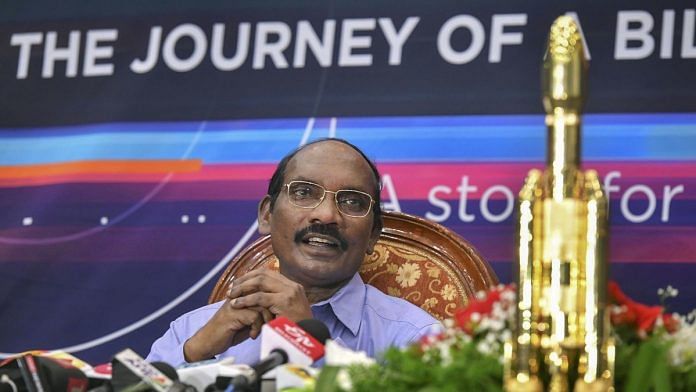Bengaluru: In a major feat for India’s second lunar mission, the Chandrayaan-2 successfully entered the moon’s orbit Tuesday, announced the Indian Space Research Organisation in Bengaluru. The next big test now is after two weeks when the spacecraft lands on the moon’s unexplored South Pole.
The tricky Lunar Orbit Insertion (LOI) took place at 9.02 am Tuesday and the spacecraft is currently following a path of 114 km x 18,072 km at an inclination of 88 degrees.
Addressing the media, ISRO Chairman K. Sivan said Chandrayaan-2 will spend the next few days adjusting its orbit around the moon and lowering steadily to a circular path of 100 km passing over the moon’s poles. This will be the final orbit for the rest of its mission.
Once Chandrayaan-2 is settled in its final orbit around the moon, the lander Vikram will be released. This is expected to occur on 2 September. The lander will touch down near the South Pole of the moon at 1:55 am IST on 7 September. The rover Pragyan will then be deployed on the lunar surface by 5:55 am IST the same day.
“Even though we’ve successfully entered the Moon’s orbit, the landing is still terrifying. Everything that led up to today has been done before. But what happens on 7 September will be the first time for us,” Sivan said.
The chairman also clarified that to make up for lost days due to the delayed launch, the Earth-bound burns of the spacecraft were planned in such a way that its trajectory to the Moon can be corrected to achieve a landing on 7 September without delay.
Chandrayaan-2, launched on 22 July by GSLV MkIII-M1 vehicle, had entered the Lunar Transfer Trajectory on 14 August.
Also read: In Pictures: ISRO releases images of Earth taken by Chandrayaan 2
Moon landing on September 7
To finalise the exact spot of landing — between 71 degrees South and 22.8 degrees East of the equator (between the Manzinus C and Simpelius N craters) — the spacecraft needs to be at an orbit of 90 degrees in order to scan the lunar surface while adjusting its path around the Moon. This will help the craft to zero in on a level ground for landing.
To adjust its orbit around the moon, Chandrayaan-2 will perform four more engine burns so that its speed and altitude can be adjusted. The first one is scheduled for 21 August between 12:30-13:30 hrs IST, followed by one each on 28 August, 30 August and 1 September. After this, an 100 km x 100 km orbit will be achieved.
The lander will then be released from the orbiter.
Despite having only a 37 per cent success rate for lunar landing, Sivan said the space agency is highly confident of things going smoothly. India’s lunar landing mission comes close on the heels of Israel’s unsuccessful private attempt to do the same.
When released, the lander Vikram will enter an orbit of 100 km x 30 km, from where it will perform a series of braking manoeuvres to reach an optimal speed during touchdown.
On 3 September, there will be a manoeuvre for three seconds to establish normalcy. On 4 September, a 6.5 second manouvre is planned to lower the lander’s orbit to 35 km x 97 km.
The next three days are expected to be taken up for health and systems checks.
On 7 September, at 1.40 am IST (6 September, 20:10 hrs UTC), the lander will start performing powered descent and touch down 15 minutes later, at 1.55 am IST.
During the process of descent, the camera on the body of the lander will take pictures of the lunar surface. It will also capture immediate images of the Moon upon landing as well as of the deployment and movement of the rover.
The first pictures will be available about 5.5 hours after landing, said Sivan. These will be released by 7.30 am IST on 7 September.
Upon successful landing, India will become the fourth country to soft land on the Moon, after Russia, USA, and China.
Also read: Chandrayaan-2 launch proves India is a major player in the race for space dominance
The moon stay
After the lander touches down on the lunar surface, it will perform a series of health checks for two hours. Post that, the rover’s ramp will open on to the lunar surface. At 3 hours 10 mins after landing, the solar panel of the rover will be deployed to supply power to the non-autonomous rover and get it ready for deployment.
At 5.45 am IST on 7 September, 3 hours and 50 mins after landing, the rover will be released. At 5.55 am IST (7 September, 12:25 UTC), four hours after landing, the rover will roll down the ramp and touch the Moon’s surface.
As of now, Vikram and Pragyan are expected to function for 14 Earth days while the orbiter will work for at least a year.
Responding to a question from ThePrint, Sivan said ISRO will attempt to communicate again with the lander and the rover after the 14 days of lunar night.
If the systems continue to be in good health through residual power from solar charging, they are expected to be up and running again after a gap of 14 days.
The Chandrayaan-2 mission will study water on the moon, seismic activity, heat conductivity of the surface, mineralogy, surface chemistry, and more, with new science results expected from the southern polar region of the moon.
Also read: Chandrayaan-2 ‘cheaper than Interstellar’, but India’s space ambition can’t be about cost






